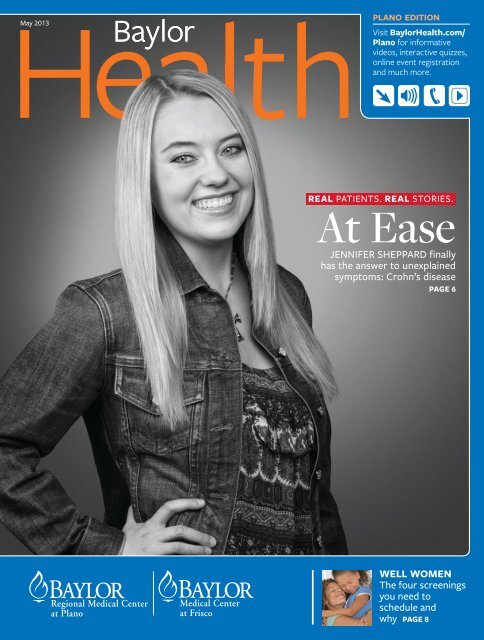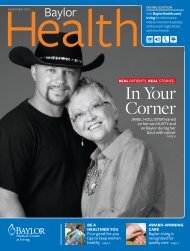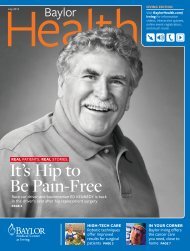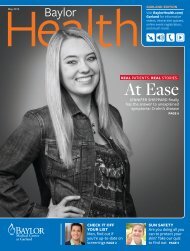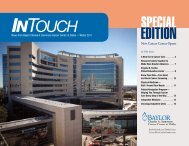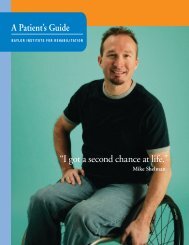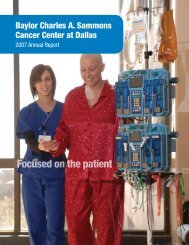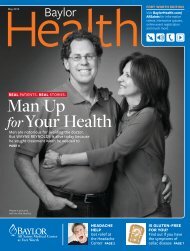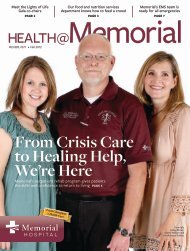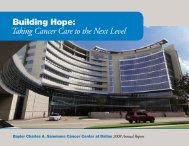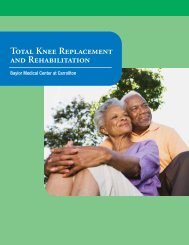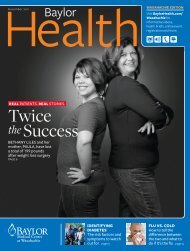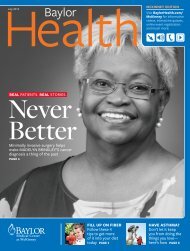Plano - Baylor Health Care System Online Newsroom
Plano - Baylor Health Care System Online Newsroom
Plano - Baylor Health Care System Online Newsroom
You also want an ePaper? Increase the reach of your titles
YUMPU automatically turns print PDFs into web optimized ePapers that Google loves.
<strong>Health</strong><br />
May 2013<br />
<strong>Baylor</strong><br />
PLANO EDITION<br />
Visit <strong>Baylor</strong><strong>Health</strong>.com/<br />
<strong>Plano</strong> for informative<br />
videos, interactive quizzes,<br />
online event registration<br />
and much more.<br />
REAL PATIENTS. REAL STORIES.<br />
At Ease<br />
JENNIFER SHEPPARD finally<br />
has the answer to unexplained<br />
symptoms: Crohn’s disease<br />
PAGE 6<br />
WELL WOMEN<br />
The four screenings<br />
you need to<br />
schedule and<br />
why PAGE 8
Need an Inside Look<br />
Advanced imaging is key<br />
to diagnosing health problems<br />
and getting treatment<br />
started. The imaging<br />
specialists on the medical<br />
staff at <strong>Baylor</strong> Regional<br />
Medical Center at <strong>Plano</strong><br />
use advanced technology<br />
to get high-quality images<br />
for screening and diagnostic<br />
tests. And they make it<br />
simple for you with easy<br />
access, quick report turnaround<br />
times and convenient<br />
appointments.<br />
“The radiology department<br />
offers a friendly<br />
environment staffed with<br />
highly skilled radiologists,<br />
technologists and nurses,<br />
and equipped with modern<br />
technology,” says David<br />
Kim, MD, medical director<br />
of imaging and a radiologist<br />
on the medical staff at<br />
<strong>Baylor</strong> <strong>Plano</strong>.<br />
The imaging capabilities<br />
at <strong>Baylor</strong> <strong>Plano</strong> include:<br />
• Barium X-ray (upper and<br />
lower gastrointestinal)<br />
• Interventional radiology<br />
including arteriogram<br />
(angiogram)<br />
• Computed tomography<br />
(CT) scan<br />
• Digital fluoroscopy<br />
• Digital X-ray<br />
• Low-dose chest CT scan<br />
• Intravenous<br />
pyelogram (IVP)<br />
Schedule a<br />
Screening<br />
For more information<br />
about the imaging<br />
and radiology services<br />
at <strong>Baylor</strong> <strong>Plano</strong>, visit<br />
<strong>Baylor</strong><strong>Health</strong>.com/<br />
<strong>Plano</strong>Imaging or call<br />
1.800.4BAYLOR.<br />
• Magnetic resonance<br />
imaging (MRI)<br />
• Mammogram<br />
• Ultrasound<br />
• Nuclear medicine<br />
All images are produced<br />
digitally so they can be<br />
transferred to providers<br />
throughout the <strong>Baylor</strong><br />
network and stored and<br />
viewed on the computer.<br />
Women who would<br />
like to schedule screening<br />
mammograms<br />
can now book their<br />
appointments online<br />
at <strong>Baylor</strong><strong>Health</strong>.com/<br />
<strong>Plano</strong>BreastImaging.<br />
Other imaging studies<br />
require a doctor’s referral.<br />
Stroke<br />
Certified<br />
In January, <strong>Baylor</strong><br />
Regional Medical<br />
Center at <strong>Plano</strong><br />
received recognition<br />
from The Joint<br />
Commission as a certified<br />
stroke center. Certification<br />
means that <strong>Baylor</strong> <strong>Plano</strong><br />
meets or exceeds the<br />
up-to-date standards of<br />
evidence-based care and<br />
stays current on the latest<br />
developments in diagnosing<br />
and treating stroke.<br />
With certification, local<br />
emergency medical services<br />
teams can bring people with<br />
signs of stroke to <strong>Baylor</strong><br />
<strong>Plano</strong> and treatment can<br />
begin right away. Certain<br />
medications for stopping<br />
stroke need to be administered<br />
quickly to help prevent<br />
damage and save brain cells.<br />
<strong>Baylor</strong> <strong>Plano</strong> takes part in<br />
many community events to<br />
raise the awareness of calling<br />
911 right away if stroke is<br />
suspected. Warning signs to<br />
watch for include difficulty<br />
speaking, seeing or walking,<br />
as well as sudden, severe<br />
headache and numbness on<br />
one side of the body.<br />
CORRECTION: In the March 2013 issue of <strong>Baylor</strong><strong>Health</strong> magazine, Sacheen Mehta, MD,<br />
a board-certified orthopedic surgeon on the medical staff at <strong>Baylor</strong> Regional Medical<br />
Center at <strong>Plano</strong>, should have been quoted as a source in the article titled “Is It Time”<br />
We apologize for the error.<br />
Your Call<br />
After a Stroke<br />
For a referral to a neurologist<br />
on the <strong>Baylor</strong> <strong>Plano</strong> medical<br />
staff, call 1.800.4BAYLOR.<br />
<strong>Baylor</strong> Regional Medical Center at <strong>Plano</strong>, 4700 Alliance Blvd., <strong>Plano</strong>, TX 75093. 469.814.2000. Giving Opportunities/<strong>Baylor</strong> <strong>Health</strong> <strong>Care</strong> <strong>System</strong> Foundation: 214.820.3136. <strong>Baylor</strong> <strong>Health</strong> <strong>Care</strong> <strong>System</strong> Mission:<br />
Founded as a Christian ministry of healing, <strong>Baylor</strong> <strong>Health</strong> <strong>Care</strong> <strong>System</strong> exists to serve all people through exemplary health care, education, research and community service. President and CEO, <strong>Baylor</strong> <strong>Health</strong><br />
<strong>Care</strong> <strong>System</strong>: Joel Allison.<br />
President, <strong>Baylor</strong> Regional Medical Center at <strong>Plano</strong>: Jerri Garison. President, <strong>Baylor</strong> Regional Medical Center at Frisco: William A. Keaton. <strong>Baylor</strong> <strong>Plano</strong> Board of Trustees: Glenn Callison, JD; Jerry Carlisle<br />
Jr., DMin; Joey Carter; James Dahlgren; Toni P. Jenkins, EdD; Roy Lamkin; C. Thomas Long III, MD; Clarence Miller; Doug Otto, EdD; Ronald Parker; Valerie Richardson, MBA; Lisa Sams; Charles Toulson, MD;<br />
Jennifer Zimmer, MD<br />
<strong>Baylor</strong> Regional Medical Center at Frisco Board of Trustees: Mickey Morgan, MD, Chairman; Brett Brodnax, Vice Chairman; Michael Taylor, Secretary; Jimmy Laferney, MD, VP<br />
Medical Staff Affairs; LaVone Arthur; Johnny Bond; Mark Allen, MD; Doug Smrekar, MD.<br />
The material in <strong>Baylor</strong><strong>Health</strong> is not intended for diagnosing or prescribing. Consult your physician before undertaking any form of medical treatment or adopting any exercise<br />
program or dietary guidelines. Physicians are members of the medical staff at one of <strong>Baylor</strong> <strong>Health</strong> <strong>Care</strong> <strong>System</strong>’s subsidiary, community or affiliated medical centers and are<br />
neither employees nor agents of those medical centers, <strong>Baylor</strong> Regional Medical Center at <strong>Plano</strong>, <strong>Baylor</strong> Medical Center at Frisco or <strong>Baylor</strong> <strong>Health</strong> <strong>Care</strong> <strong>System</strong>. Photographs may<br />
include models or actors and may not represent actual patients. <strong>Baylor</strong><strong>Health</strong> is published six times a year by McMurry/TMG, LLC, for friends and supporters of <strong>Baylor</strong> Regional<br />
Medical Center at <strong>Plano</strong> and <strong>Baylor</strong> Medical Center at Frisco. © 2013 <strong>Baylor</strong> <strong>Health</strong> <strong>Care</strong> <strong>System</strong>. If you are receiving multiple copies, need to change your mailing address or do<br />
not wish to receive this publication, please send your mailing label(s) and the updated information to Robin Vogel, <strong>Baylor</strong> <strong>Health</strong> <strong>Care</strong> <strong>System</strong>, 2001 Bryan St., Suite 750, Marketing<br />
Department, Dallas, TX 75201, or email the information to robinv@baylorhealth.edu.<br />
2 <strong>Baylor</strong><strong>Health</strong>.com<br />
©Jupiter Images
<strong>Baylor</strong><br />
_<br />
Makes<br />
Us All Better<br />
<strong>Baylor</strong> Foundation has<br />
set a goal of raising<br />
$250 mil lion by 2015 to<br />
strengthen every aspect<br />
of <strong>Baylor</strong>. It marks our<br />
most ambitious fundraising<br />
effort to date. Visit<br />
Give.<strong>Baylor</strong><strong>Health</strong>.com<br />
for more information.<br />
Home<br />
Sweet<br />
Medical<br />
Home<br />
Home is where people<br />
know you and your<br />
history. The same is true<br />
in a patient-centered<br />
medical home. In this<br />
team-based model of care,<br />
a primary physician acts as a<br />
“home base” for providing and coordinating<br />
all of a patient’s health care needs.<br />
The National Committee for Quality<br />
Assurance, which evaluates the effectiveness<br />
of clinics following the patient-centered<br />
medical home model, has awarded <strong>Baylor</strong><br />
<strong>Health</strong> <strong>Care</strong> <strong>System</strong>’s <strong>Health</strong>Texas Provider<br />
Network the highest possible level of<br />
recognition for every one of its 60 clinics<br />
that submitted applications. That’s the<br />
second-highest total number of recognitions<br />
of any medical group in the country.<br />
With an emphasis on prevention and<br />
successfully managing chronic diseases,<br />
the patient-centered medical home matches<br />
patients with a primary care physician who<br />
knows every doctor they see, every test or<br />
procedure they receive and every medication<br />
they take.<br />
Snore Alert<br />
Snoring may be more than a nuisance. It may<br />
signal an increased risk of cardiovascular<br />
disease. That’s because some snorers have<br />
sleep apnea, in which they briefly stop<br />
breathing while they sleep. And untreated<br />
sleep apnea increases risk for heart attack,<br />
stroke and heart failure.<br />
But even garden-variety snoring may be<br />
a sign of trouble. A recent study found that<br />
WHEN THE PROSTATE<br />
CAUSES PROBLEMS<br />
Did you know that a man’s prostate<br />
gland continues to grow throughout<br />
adulthood But if it gets too big, or<br />
enlarged, it can cause symptoms.<br />
More than half of men in their 60s,<br />
and as many as 90 percent in their<br />
70s and 80s, have some signs of an<br />
enlarged prostate, also called BPH<br />
for benign prostatic hyperplasia or<br />
Get Sleep<br />
Support<br />
To learn how we can<br />
help keep your heart<br />
healthy by providing a<br />
better night’s sleep, visit<br />
<strong>Baylor</strong><strong>Health</strong>.com/<br />
Sleep today.<br />
snorers were more likely to have thickening in the carotid artery that supplies<br />
blood to the brain, which is associated with coronary artery disease.<br />
hypertrophy. Talk to your doctor if<br />
you experience:<br />
• A weak or interrupted stream<br />
of urine<br />
• Frequent urination<br />
• Urinary urgency or leaking<br />
The condition can be treated<br />
with medication, nonsurgical<br />
treatments or surgery.<br />
Do You Have Symptoms<br />
If you have signs of an enlarged prostate, your doctor can help determine which<br />
treatment is best for you. Visit FindDrRight.com for a free physician referral.<br />
<strong>Baylor</strong><strong>Health</strong>.com 3
We’ve<br />
Got Your<br />
Back<br />
We take a closer<br />
look at your spine<br />
and pinpoint what<br />
can go wrong<br />
WHEN YOU CONSIDER how<br />
complex the anatomy of the spine<br />
is—muscles, ligaments, disks,<br />
vertebrae, nerves and the spinal<br />
cord—it’s no wonder back injuries<br />
are so common.<br />
“Nearly everyone has one at some<br />
point,” says Richard Hostin, MD,<br />
medical director of orthopedics at<br />
<strong>Baylor</strong> Regional Medical Center at<br />
<strong>Plano</strong>. “Most back pain can be treated<br />
with conservative measures, such as<br />
rest, nonsteroidal anti-inflammatory<br />
drugs, stretching and physical therapy. Escalating back pain,<br />
weakness, numbness or change in bowel or bladder control may<br />
indicate a problem requiring evaluation by your physician.”<br />
Here, we explore key components of the spine.<br />
THE GUARDIANS<br />
VERTEBRAE: These bones that make up your spine protect<br />
your spinal cord and nerves. A trauma, such as a bad fall or a<br />
car accident, can lead to a break or a fracture in your vertebrae.<br />
For older adults with osteoporosis (a disease that weakens the<br />
bones), compression fractures are also common.<br />
“In the older and osteoporotic patient, something as simple<br />
as rolling over in bed in the morning can cause a compression<br />
fracture,” Dr. Hostin says.<br />
THE SHOCK ABSORBERS<br />
DISKS: These pads are situated between the vertebrae and<br />
prevent these bones from rubbing together. Over time, your<br />
disks can degenerate, which can cause pain. Additionally, an<br />
injury can result in a herniated disk, meaning the disk’s core<br />
protrudes through its outer casing. If it presses against the<br />
nearby nerves, it can be very painful.<br />
THE COURIERS<br />
NERVES: Nerves in the spine<br />
carry signals from the brain and<br />
spinal cord to the rest of the<br />
body. A herniated disk can put<br />
pressure on a nerve, resulting<br />
in pain. It’s important to<br />
remember that pinched nerves<br />
anywhere in the spine can<br />
Battling<br />
Back Pain<br />
Get help. For a<br />
physician referral, visit<br />
FindDrRight.com or<br />
call 1.800.4BAYLOR.<br />
result in discomfort in your arms and legs. So, if you’re feeling<br />
pain or numbness in your arms or legs, it’s important to see<br />
your doctor.<br />
“A lot of people think that if they don’t have pain in their<br />
back, it’s not a back injury,” Dr. Hostin says. “But that isn’t<br />
necessarily the case.”<br />
THE COMMAND CENTER<br />
SPINAL CORD: The spinal cord runs from the base of the<br />
skull all the way down your spine. A spinal cord injury can<br />
occur when the vertebrae are fractured or dislocated and then<br />
threaten to injure or even sever the spinal cord. A spinal cord<br />
injury is very serious and requires immediate medical attention.<br />
4 <strong>Baylor</strong><strong>Health</strong>.com
HOW SKIN SAVVY<br />
ARE YOU<br />
Take our quick quiz<br />
to test your skin<br />
protection skills<br />
Do you have what it takes to safeguard your skin from harmful<br />
ultraviolet rays See how your answers stack up against our expert,<br />
Paul Martinelli, MD, a dermatologist on the medical staff at <strong>Baylor</strong><br />
Regional Medical Center at <strong>Plano</strong>.<br />
What level<br />
1 of SPF<br />
do experts<br />
recommend<br />
A. 15<br />
B. 30<br />
C. 45<br />
B. The American<br />
Academy of<br />
Dermatology and<br />
the Skin Cancer<br />
Foundation raised<br />
the recommendation<br />
from 15 SPF (sun<br />
protection factor)<br />
to 30 SPF or higher,<br />
because most people<br />
don’t apply enough<br />
sunscreen. Look for<br />
“broad-spectrum”<br />
coverage (with<br />
UVA and UVB<br />
protection), and<br />
apply at least<br />
1 ounce on your<br />
face, arms and<br />
legs, and another<br />
ounce if you’re in<br />
a bathing suit on<br />
your chest and back,<br />
Dr. Martinelli says.<br />
2<br />
You can get<br />
sunburned<br />
when it’s cloudy.<br />
TRUE or FALSE<br />
TRUE. “Depending on<br />
how thick the clouds<br />
are, 80 percent of<br />
the sun’s UV rays can<br />
come through—even<br />
in the wintertime,”<br />
Dr. Martinelli says.<br />
“That’s why it’s so<br />
important to wear<br />
sunscreen even if it’s<br />
not sunny.”<br />
What are the<br />
3 most common<br />
sunscreen<br />
mistakes<br />
A. Applying too much<br />
sunscreen.<br />
B. Neglecting key<br />
areas, such as the<br />
ears and neck.<br />
C. Putting sunscreen<br />
on after you’re<br />
outside.<br />
B and C: “I find<br />
that patients will<br />
frequently miss their<br />
lips, ears, neck and the<br />
tops of their feet,”<br />
Dr. Martinelli says.<br />
And most sunscreens<br />
need to be applied<br />
15 minutes before<br />
you go outside to<br />
provide protection.<br />
“Only titanium<br />
dioxide and zinc<br />
oxide are effective<br />
immediately,” he says.<br />
4<br />
You can get<br />
skin cancer<br />
even if you don’t<br />
spend a lot of<br />
time in the sun.<br />
TRUE or FALSE<br />
TRUE. While basal<br />
and squamous cell<br />
cancers are directly<br />
linked to UV exposure,<br />
melanoma is different.<br />
“There’s a genetic<br />
component that puts<br />
you at a higher risk<br />
for developing it, or if<br />
you have many, many<br />
moles—regardless of<br />
any sun exposure,”<br />
Dr. Martinelli says.<br />
“That’s why we<br />
encourage patients to<br />
do full-body, self-skin<br />
checks regularly and<br />
to see a dermatologist<br />
if they have any doubt<br />
about a spot.”<br />
5<br />
Tanning beds<br />
are a safe way<br />
to get vitamin D.<br />
TRUE or FALSE<br />
FALSE. “Tanning<br />
beds typically use UVA<br />
bulbs, and an easy way<br />
to remember what<br />
UVA does is to think<br />
that the ‘A’ stands<br />
for aging. It’s going<br />
to cause wrinkles,<br />
and it’s going to<br />
increase your risk<br />
for skin cancer, too,”<br />
Dr. Martinelli says.<br />
“UVB rays—in which<br />
the ‘B’ stands for<br />
burn—are the rays<br />
that are used to make<br />
vitamin D in your<br />
body.” And remember:<br />
You can get your D<br />
from dietary sources<br />
like milk or by taking<br />
a supplement.<br />
See a Suspicious Spot<br />
For a referral to a dermatologist on<br />
the medical staff at <strong>Baylor</strong> <strong>Plano</strong>, visit<br />
<strong>Baylor</strong><strong>Health</strong>.com/<strong>Plano</strong> today.<br />
Sandals and sunscreen ©Getty Images/iStockphoto; Girl and mother ©Getty Images <strong>Baylor</strong><strong>Health</strong>.com 5
REAL PATIENTS. REAL STORIES.<br />
After being diagnosed<br />
with Crohn’s disease,<br />
Jennifer Sheppard<br />
changed her diet and<br />
got smarter about<br />
handling stress.<br />
Gut<br />
Check<br />
Time<br />
3 ways to help<br />
your digestive<br />
system run<br />
smoothly<br />
J<br />
Jennifer Sheppard knew her illness<br />
wasn’t in her head. She had severe<br />
abdominal pain, had lost nearly<br />
40 pounds without trying and her<br />
hair was falling out. But no one<br />
had answers for her. That was until<br />
she went to the emergency room<br />
at <strong>Baylor</strong> Medical Center at Irving,<br />
where she was diagnosed with<br />
Crohn’s disease, an autoimmune<br />
condition that causes inflammation<br />
in the digestive system. Common<br />
symptoms range from diarrhea to<br />
joint pain to skin problems.<br />
“I had never heard of it, so it<br />
was a huge learning experience<br />
for me,” Sheppard says. “The<br />
doctors and nurses answered<br />
every question I had and made me<br />
feel comfortable. They put me at<br />
ease about my diagnosis.”<br />
Watch Jennifer’s Story<br />
Hear Jennifer talk more about her experience at <strong>Baylor</strong><strong>Health</strong>.com/Exclusive today.<br />
6 <strong>Baylor</strong><strong>Health</strong>.com
Sheppard spent most of 2010<br />
adjusting to life with Crohn’s<br />
disease and the new medication<br />
it required. She had to change her<br />
diet and learn to manage her stress<br />
levels to keep symptoms at bay.<br />
“I can’t eat raw vegetables because<br />
things that aren’t fully cooked<br />
feel like glass going through my<br />
stomach,” Sheppard says.<br />
Now, the 27-year-old is going<br />
back to school, where she is<br />
1THE KEY<br />
2<br />
3<br />
INGREDIENT<br />
studying business and psychology.<br />
And she’s back to work at a western<br />
store in downtown Dallas. “This<br />
is the first year in a long time that<br />
I’ve felt normal,” Sheppard says.<br />
“It’s easy to have a pity party<br />
about this, but you just have to<br />
keep on keeping on. You have to<br />
take care of yourself.”<br />
Are you dealing with your own<br />
stomach troubles Adopt these<br />
three tips for digestive success.<br />
The first step to a happy stomach is to<br />
examine your diet. And for most people that<br />
means making sure you’re eating a balanced<br />
diet with plenty of fiber, which will keep your digestive system moving<br />
efficiently, says John Hyatt, MD, a gastroenterologist on the medical<br />
staff at <strong>Baylor</strong> Regional Medical Center at <strong>Plano</strong>. “Choose foods like<br />
green vegetables, corn and beans,” he says. For fiber-rich fruits, opt for<br />
raspberries, pears and apples.<br />
Just how much fiber do you need Women should aim for 25 grams<br />
each day, while men should get 38 grams, according to the Academy of Nutrition and<br />
Dietetics. That’s not hard to do if you incorporate whole grains, plenty of produce<br />
and beans into your daily diet.<br />
JUST ADD<br />
WATER<br />
Think of water as the oil that greases<br />
your digestive system’s wheels.<br />
“Dehydration leads to constipation<br />
and a lot of other gastrointestinal issues,” Dr. Hyatt says.<br />
Keep this in mind, too: The adage of drinking eight glasses of<br />
water a day may not apply to you. Talk to your doctor about the<br />
specific amount you need, and look beyond the glass. Lettuce,<br />
watermelon, grapefruit, broccoli, and low-fat milk and yogurt<br />
can help you get the fluids you need with a little flavor.<br />
SIT BACK<br />
AND RELAX<br />
“There’s a strong connection between the<br />
brain and the gut,” Dr. Hyatt says. For people<br />
with digestive problems, such as Crohn’s<br />
disease, irritable bowel syndrome or ulcers, anxiety only fans the<br />
flames of discomfort. But even those without a chronic condition can<br />
experience constipation or diarrhea when under too much pressure.<br />
Since it’s virtually impossible to avoid stress in this day and age, it’s<br />
important to arm yourself with the tools to combat it. Exercising, eating<br />
well and getting enough sleep can all contribute to a calmer you. Take<br />
it a step further by meditating, practicing deep breathing techniques and making time<br />
for the things you love, whether that’s reading, scrapbooking or soccer. You (and your<br />
stomach) will be glad you did.<br />
Take the First Step<br />
to <strong>Health</strong>y Eating<br />
To schedule an appointment with<br />
a dietitian on staff at <strong>Baylor</strong> <strong>Plano</strong>,<br />
get a referral from your physician<br />
and then call 469.814.4483.<br />
Don’t Fight<br />
Food<br />
Whether you<br />
have special<br />
dietary needs or<br />
you’re trying to eat<br />
to control diabetes or manage<br />
weight, <strong>Baylor</strong> Regional Medical<br />
Center at <strong>Plano</strong>’s outpatient<br />
nutrition counseling program<br />
can help. Here’s how:<br />
Individual appointments.<br />
If you have diabetes, weight<br />
management issues, acid reflux,<br />
irritable bowel syndrome,<br />
Crohn’s disease, celiac disease<br />
or some other condition, a<br />
dietitian can recommend<br />
dietary changes to help you get<br />
healthier and meet your goals.<br />
“Most people have a follow-up<br />
appointment after three to four<br />
weeks, and some people go on<br />
to have monthly meetings for<br />
some time depending on their<br />
needs,” says Megan Moore, a<br />
registered dietitian on staff at<br />
<strong>Baylor</strong> <strong>Plano</strong>.<br />
Diabetes classes. People<br />
with diabetes can attend a fiveclass<br />
series covering a range<br />
of aspects of the disease. One<br />
two-hour class focuses entirely<br />
on nutrition.<br />
Weight loss surgery<br />
classes. People who are<br />
planning weight loss surgery can<br />
attend a four-class series to learn<br />
what dietary changes they will<br />
need to make after surgery.<br />
Broccoli and grapefruit ©Getty Images/iStockphoto<br />
<strong>Baylor</strong><strong>Health</strong>.com 7
Make time for<br />
yourself—and<br />
your health—<br />
this Mother’s Day<br />
Greatest<br />
The<br />
Gift<br />
As a mom, you typically<br />
take care of everyone<br />
else in the family first.<br />
But to continue to play<br />
the role of caretaker<br />
for years to come,<br />
you have to look after<br />
yourself, too. In honor<br />
of Mother’s Day, give<br />
yourself the gift of good<br />
health and take the<br />
time to schedule these<br />
important screenings.<br />
MAMMOGRAM<br />
There are no sure things in medicine,<br />
but mammograms, which can find<br />
breast cancer in its earliest stages,<br />
come pretty close.<br />
“Mammograms, which are X-ray<br />
images of the breast, can detect<br />
something before we can see or feel it,”<br />
says Christina Kuo, MD, an internal<br />
medicine physician on the medical staff<br />
at <strong>Baylor</strong> Regional Medical Center at<br />
<strong>Plano</strong>. “And because early detection<br />
is key to effectively treating cancer,<br />
mammograms are our best line of<br />
defense against breast cancer.”<br />
Dr. Kuo recommends getting a<br />
mammogram every year, beginning at<br />
age 40. “Risk increases as you age, so<br />
you never graduate from breast cancer<br />
screenings,” she says. “By the time<br />
you are 80 years old, you have a 1 in 8<br />
chance of developing breast cancer.”<br />
And keep in mind that you may<br />
need to start screening earlier based<br />
on family history. “Typically, we<br />
recommend women have the exam 10<br />
years before the age that their firstdegree<br />
relative was when they had<br />
their first diagnosis,” Dr. Kuo says.<br />
8 <strong>Baylor</strong><strong>Health</strong>.com<br />
Mother and daughter ©Getty Images/Comstock Images.
Schedule Your<br />
Mammogram<br />
Spa Day<br />
Make your screening<br />
mammogram appointment<br />
online at <strong>Baylor</strong><strong>Health</strong>.com/<br />
<strong>Plano</strong>BreastImaging or<br />
call 469.814.5500.<br />
COLONOSCOPY<br />
While colonoscopy gets a bad<br />
reputation, the exam’s ability to<br />
detect cancer early has made it one<br />
of the stars of the screening world.<br />
Most adults should schedule their<br />
first colonoscopy at age 50. “There’s<br />
really no reason to do it sooner, unless<br />
there’s a family history or there’s the<br />
presence of a bowel disease, such as<br />
Crohn’s,” Dr. Kuo says.<br />
“While these aren’t anyone’s<br />
favorite exams, they can be lifesaving.<br />
Colon cancer can remain silent until<br />
it’s too late, and it has already spread,”<br />
Dr. Kuo says.<br />
CARDIAC EXAMS<br />
Heart disease is the No. 1 killer<br />
of women in the United States,<br />
according to the American Heart<br />
Association, so it’s important to stay<br />
on top of your ticker. “By age 50,<br />
every woman needs to be having an<br />
EKG and blood work every year to<br />
check the health of her heart and<br />
lungs,” Dr. Kuo says. “Heart disease<br />
doesn’t have any noticeable symptoms,<br />
so these checks are essential.”<br />
But keeping tabs on heart health<br />
doesn’t start at 50. Beginning at<br />
age 21, your doctor should monitor<br />
your cholesterol, blood pressure and<br />
other risk factors every five years<br />
or so. “Once you hit 40, cholesterol<br />
screenings should happen every<br />
other year,” Dr. Kuo adds.<br />
Be honest with your physician<br />
about risk factors, such as smoking,<br />
stress and diet. Your doctor can help<br />
you improve your habits now, which<br />
will lower your risk for heart disease<br />
in the future.<br />
“Talking to your doctor and<br />
having these exams can help women<br />
avoid serious issues down the road,”<br />
Dr. Kuo says.<br />
Treat Yourself to<br />
a Mammogram<br />
Taking the time to have a<br />
mammogram can seem like<br />
just one more “to-do” on<br />
a long list of obligations.<br />
But <strong>Baylor</strong> Regional<br />
Medical Center at <strong>Plano</strong> is<br />
aiming to make screening<br />
mammograms something<br />
you can look forward to<br />
with mammogram spa days.<br />
“The whole concept is<br />
that we want to create an<br />
atmosphere where women<br />
can take a little time for<br />
themselves while at the<br />
same time promoting their<br />
health,” says Elizabeth<br />
Jekot, MD, medical director<br />
of breast imaging at <strong>Baylor</strong><br />
<strong>Plano</strong>’s Elizabeth Jekot MD<br />
Breast Imaging Center.<br />
The spa days include a<br />
10-minute chair massage,<br />
a snack and a small gift,<br />
and the schedule is designed<br />
so women can get in and<br />
out quickly.<br />
The next mammogram<br />
spa day is May 18, at the<br />
Elizabeth Jekot MD Breast<br />
Imaging Center.<br />
PELVIC EXAM AND PAP TEST<br />
In recent years, the recommended<br />
frequency of gynecological exams has<br />
changed. While most women refer to<br />
their annual screening as a Pap test, it<br />
is actually the pelvic exam that should<br />
be done every year. “The Pap smear is<br />
just a portion of the pelvic exam, and the<br />
recommendations for Pap are changing,”<br />
Dr. Kuo says.<br />
A pelvic exam involves a comprehensive<br />
check of your entire pelvic area; a Pap<br />
smear entails taking a few cells from your<br />
cervix to check for abnormalities, which<br />
could signal cervical cancer.<br />
“While it used to be that women should<br />
have a Pap every year with their pelvic<br />
exam, that has changed to a recommendation<br />
of every three to five years for the Pap<br />
smear for certain populations,” she adds.<br />
Confused “Every adult woman, no<br />
matter her age, should get a pelvic exam<br />
every year,” Dr. Kuo says. “Talk to your<br />
doctor about how often you need a Pap<br />
smear.” And, she says, that advice holds<br />
true for health screenings across the<br />
board: “If you’re unsure of what exams<br />
you need and when, ask your doctor.<br />
Don’t just ignore it.”<br />
<strong>Baylor</strong><strong>Health</strong>.com 9
One Hardworking Hormone<br />
The female hormone estrogen might help speed recovery in trauma patients<br />
NORTH TEXAS DOCTORS believe they may have found a<br />
wonder drug, something that could both increase survival<br />
rates and speed recovery in trauma patients—and clinical<br />
trials are now under way to find out. So what is this potential<br />
miracle cure Surprisingly, it’s the female hormone estrogen.<br />
PROTECTION FROM WITHIN<br />
“For years we’ve known that women experience a protective<br />
benefit from estrogen in regards to Alzheimer’s, coronary<br />
artery disease and dementia,” says Michael Ramsay, MD,<br />
president of <strong>Baylor</strong> Research Institute<br />
(BRI). “But more recently, we’ve<br />
discovered that estrogen’s unique<br />
protective abilities may<br />
be beneficial for<br />
trauma patients<br />
as well.”<br />
Preliminary<br />
laboratory<br />
research<br />
suggests that<br />
estrogen could<br />
decrease ultimate<br />
brain injury and<br />
increase survival by<br />
up to 65 percent in<br />
everything from cases of<br />
traumatic brain injury<br />
(TBI) and stroke to<br />
spinal cord injury, burns,<br />
hemorrhagic shock<br />
and sepsis.<br />
So how does it work<br />
“Shock from blood loss<br />
and trauma can damage<br />
the inner lining of blood<br />
vessels, which causes toxic<br />
molecules to be released<br />
to damage major organs,”<br />
Dr. Ramsay explains. “Estrogen<br />
seems to protect the lining and<br />
prevent the release of<br />
those molecules.”<br />
TO THE RESCUE<br />
Despite these compelling findings, there were no clinical trials<br />
studying estrogen in trauma until 2009, when a collaboration<br />
began between University of Texas Southwestern Medical<br />
Center and Parkland Memorial Hospital, joined by <strong>Baylor</strong><br />
University Medical Center at Dallas and BRI in 2010.<br />
“There have been 30 years of bench research on estrogen,<br />
but no one had previously been able to translate it into a<br />
human study,” says Jane Wigginton, MD, associate professor<br />
at UT Southwestern and principal investigator of the studies.<br />
“It’s a tribute to these organizations that they were able<br />
to get these studies off the ground.”<br />
The RESCUE (Resuscitative<br />
Endocrinology: Single-dose Clinical<br />
Uses for Estrogen) studies include<br />
a single, early IV dose of estrogen<br />
to patients with shock and TBI.<br />
Though results aren’t expected<br />
until fall 2013, expectations<br />
are high.<br />
“These studies could<br />
result in the use of a drug<br />
that is safe, inexpensive<br />
and easy to deliver—<br />
and that could forever<br />
change the way we care<br />
for trauma patients,”<br />
Dr. Wigginton says.<br />
“Truly, the whole world<br />
is watching.”<br />
Help Move<br />
Medicine<br />
Forward<br />
Visit <strong>Baylor</strong><strong>Health</strong>.com/<br />
AdvancingMedicine<br />
today to learn about<br />
research trials at <strong>Baylor</strong><br />
seeking participants.<br />
10 <strong>Baylor</strong><strong>Health</strong>.com
Get the Exclusive<br />
Visit <strong>Baylor</strong><strong>Health</strong>.com/Exclusive for lots more health and wellness content!<br />
This One’s<br />
for the Fellas<br />
EVENT Face it, guys. You get a bad rap for not paying<br />
closer attention to your health. Prove them wrong by registering<br />
for It’s a Guy Thing, a free men’s health event that includes<br />
health screenings, educational sessions and more. Sign up at<br />
<strong>Baylor</strong><strong>Health</strong>.com/GuyThing.<br />
VIDEO<br />
WALK AWAY Walking is one of the best and<br />
easiest exercises you can do. There’s no equipment<br />
to buy, and no gym membership needed. Watch our<br />
video at <strong>Baylor</strong><strong>Health</strong>.com/DigitalShort to learn how<br />
to get the most out of your next stroll.<br />
TIPSHEET<br />
STAY SAFE IN<br />
THE SUN<br />
Are you doing everything you can<br />
to prevent skin cancer Find out<br />
by downloading our tipsheet at<br />
<strong>Baylor</strong><strong>Health</strong>.com/Exclusive<br />
today.<br />
QUIZ<br />
Are You<br />
at Risk<br />
for Cervical<br />
Cancer<br />
The scary truth is that early<br />
cervical cancer has no<br />
symptoms. Take our quiz<br />
at <strong>Baylor</strong><strong>Health</strong>.com/<br />
CervicalRisk to find out<br />
if you’re at risk.<br />
BLOG<br />
Scrubbing In<br />
with <strong>Baylor</strong><br />
We’re bringing our 110 years<br />
of experience beyond the<br />
walls of our hospitals and<br />
clinics straight to you.<br />
Get the latest health care<br />
news by visiting <strong>Baylor</strong><br />
<strong>Health</strong> <strong>Care</strong> <strong>System</strong>’s<br />
new blog, Scrubbing In, at<br />
www.Scrubbing.In today.<br />
©Getty Images/iStockphoto <strong>Baylor</strong><strong>Health</strong>.com 11
<strong>Baylor</strong> <strong>Health</strong> <strong>Care</strong> <strong>System</strong><br />
2001 Bryan Street, Suite 750<br />
Marketing Department<br />
Dallas, TX 75201<br />
NON-PROFIT ORG.<br />
US POSTAGE<br />
PAID<br />
BAYLOR HEALTH<br />
COMMUNITY CALENDAR<br />
May & June 2013 Events<br />
To register, visit <strong>Baylor</strong><strong>Health</strong>.com/<strong>Plano</strong>Events or<br />
call 1.800.4BAYLOR unless otherwise noted.<br />
MAMMOGRAPHY<br />
Saturday Mammography<br />
Services 8 a.m. to<br />
noon. Register for a<br />
screening mammogram<br />
at <strong>Baylor</strong><strong>Health</strong>.com/<br />
<strong>Plano</strong>BreastImaging<br />
or call 469.814.5500.<br />
Most insurance plans are<br />
accepted.<br />
May 4 & 18; June 1 & 22:<br />
Women’s Imaging Center<br />
at <strong>Baylor</strong> Regional Medical<br />
Center at <strong>Plano</strong><br />
May 18; June 8: <strong>Baylor</strong><br />
Regional Medical Center at<br />
<strong>Plano</strong>’s Elizabeth Jekot MD<br />
Breast Imaging Center<br />
May 11; June 15: <strong>Baylor</strong><br />
Diagnostic Imaging Center<br />
at Craig Ranch<br />
SEMINARS AND<br />
SUPPORT GROUPS<br />
Weight Loss Surgery<br />
Support Group May<br />
8; June 12, 6 to 8:30 p.m.<br />
Education Center<br />
1 & 2, Garden Level<br />
at <strong>Baylor</strong> <strong>Plano</strong>.<br />
This meeting is<br />
intended for past,<br />
current and future<br />
weight loss surgery<br />
patients before or<br />
after procedure.<br />
To register, call<br />
469.814.5677.<br />
Diabetes Support<br />
Group May 9;<br />
June 13, 7 to 8 p.m.<br />
<strong>Baylor</strong> <strong>Plano</strong>.<br />
Joint Pain Seminar<br />
May 15; June 19, 6 to 7 p.m.<br />
Education Center 1, Garden<br />
Level at <strong>Baylor</strong> <strong>Plano</strong>.<br />
Cancer Survivorship<br />
Program May 28; June 25,<br />
6 to 8 p.m. Education Center<br />
1–4 on the Garden Level of<br />
<strong>Baylor</strong> <strong>Plano</strong>. Light dinner<br />
will be served.<br />
ONGOING EVENTS<br />
Diabetes Self-<br />
Management Program<br />
This program assists people<br />
of all ages in managing<br />
diabetes. Classes are offered<br />
at various times. To register,<br />
call 469.814.6896.<br />
Medical Nutrition<br />
Therapy <strong>Baylor</strong> <strong>Plano</strong><br />
offers appointments<br />
and classes at various<br />
times. To schedule<br />
an appointment, call<br />
469.814.4483.<br />
Mamma<strong>Care</strong><br />
®<br />
Breast Self-Exam<br />
Class Build<br />
confidence and<br />
skill with an<br />
introduction to the<br />
Mamma<strong>Care</strong> method<br />
of breast examination.<br />
Mamma<strong>Care</strong> is<br />
the internationally<br />
recognized standard<br />
for breast examination.<br />
During this class, you<br />
will practice on lifelike<br />
breast models that<br />
allow you to feel the<br />
difference between<br />
texture of normal tissue<br />
and lumps. To register,<br />
call 469.814.6758.<br />
Ten years of caring.<br />
Th a t’s commitment.<br />
When you care for as many members of a community<br />
as long as we have, you can’t help but care for the<br />
whole community. Over the last decade, we at <strong>Baylor</strong><br />
Medical Center at Frisco have become deeply involved<br />
in the life of this community. With over 400 physicians<br />
on our medical staff, our quality and range of services for<br />
the family continue to grow substantially. Beyond that,<br />
we’ve contributed more than 2,000 volunteer hours to<br />
Frisco in 2011 alone. So while we’ll continue providing<br />
the advanced patient care you’ve come to expect of us,<br />
please know that whether you’re inside or outside our<br />
hospital, we’re always working for your health.<br />
~ Celebrating 10 years of award-winning commitment. ~<br />
For a virtual tour or for more information, go to<br />
<strong>Baylor</strong><strong>Health</strong>.com/Frisco or call 1.800.4BAYLOR.<br />
5601 Warren Pkwy.<br />
Frisco, TX 75034<br />
Physicians are members of the medical staff at one of <strong>Baylor</strong> <strong>Health</strong> <strong>Care</strong> <strong>System</strong>’s subsidiary, community or affiliated<br />
medical centers and are neither employees nor agents of those medical centers, <strong>Baylor</strong> Medical Center at Frisco, or <strong>Baylor</strong><br />
<strong>Health</strong> <strong>Care</strong> <strong>System</strong>. © 2013 <strong>Baylor</strong> <strong>Health</strong> <strong>Care</strong> <strong>System</strong> BMCF_124_2012 BHM CE 01.13


